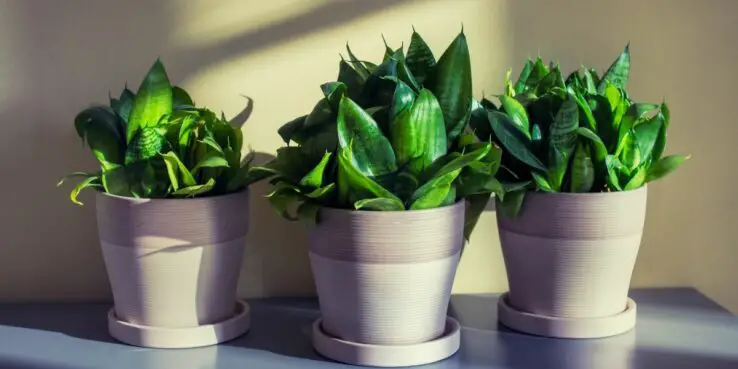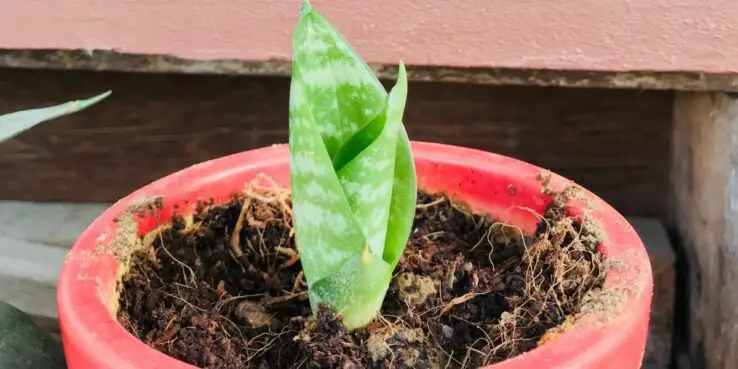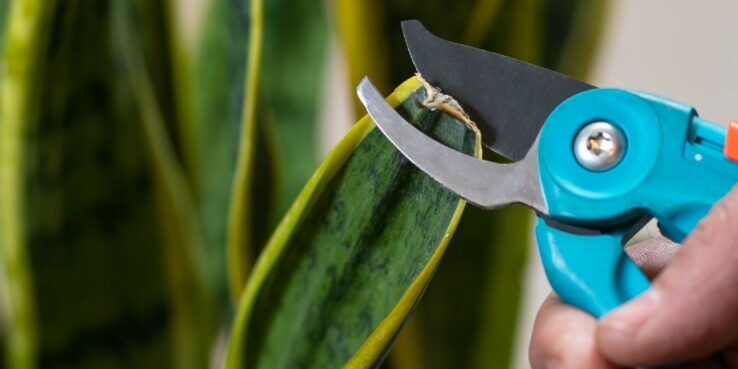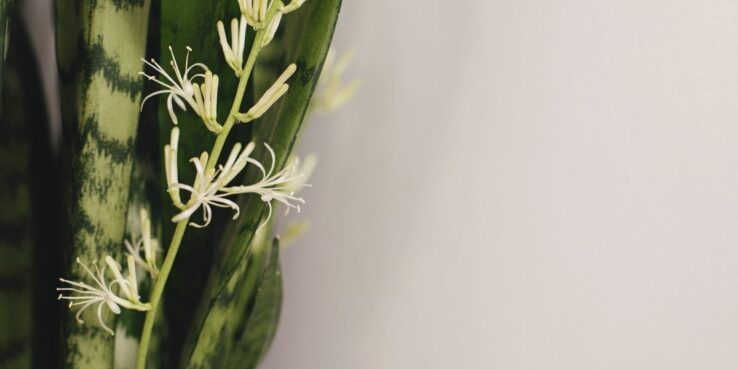
How to grow and care for snake plant
A snake plant is a houseplant that has low light requirements and requires minimal attention to survive indoors or out. It is also called mother-in-law's tongue and its botanical name is Dracaena trifasciata (formally known as Sansevieria trifasciata). It is easy to take care of.
Usually, snake plants have stripe coloration from green to gray or silver with yellow edges. It's originally from a few parts of Southern Africa. When grown outdoors, it prefers warmer weather.
In this comprehensive guide, we'll discuss everything you need to know about growing and caring for snake plants so they can thrive in your home, office, or any other low-light environment. We'll discuss different types of snake plants. We'll delve into the art of snake plant propagation techniques, and we'll explore topics like nuances of watering, the mysteries of potting and repotting, the rare occurrence of their blooming, and the potential pests and diseases that can challenge their resilience.
Additionally, we'll consider whether a snake plant is really the right choice for your indoor environment, addressing common queries through a dedicated section of frequently asked questions (FAQs).
So, let's embark on a journey to discover the secrets of flourishing alongside these elegant green companions.
Snake plant care

You may be surprised to know that snake plant care is easy. Most people are intimidated by the thought of caring for this type of houseplant because they believe it's too complicated or time-consuming, but the truth is, with minimal attention and care, your snake plant should thrive in your home or office environment.
Let's discuss how different types of these plants grow so you know what will work best for your needs!
Soil requirement
The soil snake plants prefer is a well-draining potting mix one preferably made from mostly organic matter.
A common and inexpensive option for snake plant care is to use well-draining potting soil that's mixed with one part sand. You can also mix in some perlite or pumice into the potting soil blend, which will help ensure good drainage as well as aeration.
Generally, snake plants grow well in succulents and cacti soil. You can also use an African violet soil mixture because it is also well-draining.
Watering requirement
It's best to only water your snake plant when the soil is dry. It shouldn't take long for the top inch of soil to dry out which makes it easy for you to tell if your snake plant needs watering. If this is not possible, stick your finger about one inch into the potting mix, and if moist, don't water your plant.
These indoor plants don't like to be overwatered and they should only be watered about once a month during the winter months and twice a month during the summer.
Be sure it's draining well throughout the whole pot so that the excess moisture can evaporate from the soil as soon as possible, preventing root rot. Also, try to avoid getting leaves wet during watering.
Sunlight requirement
Dracaena (sansevieria) is a tropical plant that thrives in lower light conditions which is why they're suitable for growing indoors. They will also grow well outside in full to part sun.
If you'd like to keep your snake plant inside, then it's best to place it somewhere that gets 4-6 hours of indirect sunlight each day.
Air circulation requirement
These plants are resilient to both dry or stale air in our homes and workplaces. They'll also flourish in high-humidity areas like bathrooms.
Be sure they're not placed next to heat sources like vents or furnaces that will dry the air too much.
Temperature and humidity requirement
They generally prefer hotter conditions as long as they're well watered and don't dry out too. Although snake plants can tolerate a wide range of temperatures. I.e. between 50° to 100° Fahrenheit, depending on the variety.
If your snake plant is kept in a frost, it may die, as it cannot withstand extreme cold below 50° Fahrenheit for a long period.
Snake plants flourish best at temperatures around 65°-95° Fahrenheit. For optimal comfort, set it away from drafts.
Fertilizer
During the growing season, use a mild cactus fertilizer or a balanced liquid slow-release (10-10-10) fertilizer diluted to half strength. Avoid fertilizing during the winter months.
Pruning snake plants
Pruning is the process of selectively removing plant parts such as branches, leaves, or flowers to promote healthy growth, adjust the shape of the plant, and improve its overall appearance.
The ideal time to prune a snake plant is during the growing season, which is usually spring or summer. Pruning may be done at any time of year; however, since pruning can stress a plant, it's preferable to perform it when the plant is in its healthiest state.
Remove the tallest leaves at the soil line to regulate the height of your snake plant. Remove any leaves that are damaged as well. Use sterile pruning shears, scissors, or a sharp knife. Leaves removal promotes new leaves development.
If you like to keep your original plant in good shape, it's best to remove the pups and prune their leaves.
Grow and Care for snake plant faster - Video
Different types of snake plants

Snake plants, also known as Dracaena trifasciata (Sansevieria), come in various types including compact cylindrical forms, taller sword-like varieties, and patterned cultivars, all known for their resilience and air-purifying qualities.
Here are the top 9 list of snake plants varieties that you can grow in your house. Some of them are extremely rare but most snake plants can be found easily.
- Dracaena trifasciata Laurentii - This is one of the most common snake plants you'll find in stores. The edges of this variegated snake plant are creamy yellow. It has light green with dark green stripe leaves that grow to about 2-4 feet tall. It is one of the tallest snake plant cultivar.
- Dracaena trifasciata Golden Hahnii (Bird’s Nest sansevieria) - This snake plant's broad tapered leaves have green and light green running horizontally striped markings. The leaves grow in clusters before turning leafy funnels as the plants develop. When viewed from above, the 'Golden Hahnii' has a rosette pattern to its form. This dwarf snake plant grows up to 20 cm only and needs more light. It is not like other tall leaves plants.
- Dracaena tricolor - This variety (Dracaena marginata tricolor) has a green stripe going down the middle of each variegated pale green to grayish-green colored leaf. They can reach up to 4.5 meters tall and 3 meters wide. It's best suited for bright indirect sunlight conditions (or morning sunlight).
- Dracaena trifasciata Hahnii- Hahnii plants have dark green leaves with horizontal white stripes. The foliage creates a lovely rosette shape. Their growth and reproduction are faster and can grow up to 30 cm tall. They are best suited for bright light conditions.
- Dracaena angolensis (formerly Sansevieria cylindrical or cylindrical snake plant) - This variety has up to 1.2 m long leaves that are grayish green to olive green in color. This cylindrical leaves snake plant has oval, rigid leaves, and is around 1 inch thick at the base. The leaves curve out from a central crown. It prefers bright light.
- Dracaena trifasciata 'Twist' - This variety has twisted leaves with yellow variegated edges that are striped horizontally, so giving it its name. The leaves can reach up to 14 inches tall and about 2 inches wide when grown indoors in a pot and is best suited for medium-light conditions (can survive low light but the leaves will be smaller).
- Sansevieria Moonshine (sansevieria silver queen, sansevieria moonglow, and moonlight snake plant) - The moonshine sansevieria plant is a distinctive sansevieria with pale, silvery-green, spear-shaped leaves. The dark green margin of the broad, pointed succulent leaves of the moonshine snake plant makes it an attractive plant. Moonshine plant grows up to 2 feet in height.
- Dracaena desertii - This succulent's red-tinted leaves grow to about 12 inches tall and are juicy. It is also called rhino grass.
- Sansevieria trifasciata ‘Bantel's Sensation' - This cultivar reaches up to 3 feet tall (91 cm.) and has white vertical stripes on its narrow leaves, hence the name White snake plant.
Propagating snake plants

Propagating snake plants involves creating new plants from cuttings or divisions of existing plants, allowing them to root and grow into independent specimens.
It's ideal to propagate during the snake plant growing season, which generally lasts from early spring through late summer.
If your snake plant is at least 4 inches tall, it may be split effortlessly. New branches can also develop from the ground and may be potted independently if you do not wish to divide the plant itself.
Here are the 4 different ways to propagate snake plants. Check Propagating Succulents for a more in-depth guide.
Propagate using root division
Propagating by root division involves separating a mature plant into smaller sections, each with some roots, to grow multiple new plants with established root systems.
To propagate by root division, you'll need a clean pot, cactus potting mix, and a sharp knife.
- First, pull the whole plant out of its pot, and place it on a flat surface. Gently clean the root ball from the soil.
- Divide the plant into sections so that each section has its root structure attached to it. You can cut it with a knife. It's ok, it won't kill it.
- Transplant these new plant parts into separate pots with succulent and cactus potting soil.
- Water them thoroughly, and let them grow in bright indirect sunlight.
Propagation by leaf-cutting
Propagation by leaf-cutting involves taking a healthy leaf cutting and encouraging it to grow roots and develop into a new plant.
In this method, you'll need a sterilized scissor, pruning shears, or a sharp knife, a clean pot, and well-draining potting mix, OR a clean jar if you prefer to root it in water.
- Cut a long healthy leaf from the parent snake plant with any of the above tools. Let it be callous for some time or add some growing hormones.
- Submerge the cut end in a clean jar of water or plant it in a pot with cacti soil.
- Place the new baby snake plant in a partially sunny spot.
- Change the water of the jar every few days (better every week or 2) to prevent bacterial or algae growth. OR if you are growing in soil, mist it twice every day.
- When you see root growth, you can plant your new snake plant in well-draining and fresh soil and start caring for it.
Snake plants are usually slow-growing plants, so expect to root them after 2 months. When the new growth appears, transplant/repot it to their new homes/containers.
Leaf cuttings are the most common way to propagate succulents. If you own a snake plant, you should expand it by the leaf-cutting propagation method.
Offshoots propagation
Offshoot propagation refers to cultivating new plants by removing the offshoots or small shoots that grow at the base of the parent plant.
Snake plants can be propagated from offshoots too. In this case, you'll need a sharp knife or pruning shears to cut the offshoot from the parent plant and replant it in a well-draining pot full of succulent fresh soil.
The offshoot should have its roots intact. It is one of the easiest and quick methods to grow snake plants.
Remember to put in indirect bright light or near a sunny window, and only water when the soil dries.
Propagating snake plants from seeds
Propagating from seeds involves collecting and sowing snake plant seeds to grow new ones, but it may require more time and attention compared to other propagation techniques.
The other techniques (offshoots or leaf-cutting) are considerably easier, faster, and more reliable than propagating from seeds. Snake plant seeds have a low rate of germination. It might take anything from three to six weeks for a seedling to form.
BTW, here's the method to grow new snake plants from seeds.
- Fill up a pot with cacti soil and spread the seeds on top of it. Water them to keep the seed moist and place them in a sunny spot.
- You can wrap a clear plastic over it.
- It will take time for the seed to germinate, so be patient.
- After a few weeks, new growth will appear, wait for them to grow a little more before transplanting.
- Once they grow up to 3-4 inches, separate them with a clean sharp knife or pruning shears and pick out the best one and replant it in a well-draining pot full of succulent soil.
Be careful, never let your snake plant baby or even mature snake plant outdoor when temps dip below 50° F.
Pests and Diseases

"Pests and Diseases" refer to harmful organisms and illnesses that can affect plant health. When you are growing snake plants, it's important to monitor for potential pests like scale, spider mites, or mealybugs, as well as diseases like curly leaves problem or root rot, etc., and take proactive measures such as proper watering and maintaining optimal conditions to prevent and address these issues.
Pests
Snake plants are prone to a variety of insects, including scale infestations, gnats, spider mites, aphids, mealybugs, and whiteflies. If you maintain your plant healthy, you can avoid these insect infestations. OR use a mild spray of an organic neem oil insecticide soap.
The most likely culprits are mealybugs and spider mites. Both attacks can be treated by regularly misting the leaves of the plant or taking a cotton swab dipped in rubbing alcohol or a drop of dish soap and wiping it on the affected area. Make sure to clean both sides of the leaves.
Mealybugs reproduce in a cottony substance around their body, so you can easily wipe them off with a swab dipped in rubbing alcohol.
Spider mites are barely visible to the human eye and live on the undersides of your plant's leaves. You'll have to use a magnifying glass or better yet, a small hand lens to spot them. You may also shake your plant and see if tiny dust particles fall from the leaves. Treat these with insecticidal soap or neem oil solution.
Snake plant diseases
Snake plants, renowned for their resilience, can fall prey to various ailments during cultivation. You should act quickly to avoid or heal these diseases while caring for and growing snake plants. Some common health concerns and remedies are outlined below.
Curling Leaves: Curling leaves may stem from cold or dry air or a thrips pest infestation. Maintain warmth, avoid drafts, and treat with neem oil or vegetable soap to combat pests and avoid this issue.
Leaf Discoloration (Brown Tips, Red Spots, Yellow or Brown Leaves): Yellow or brown leaves often indicate underwatering; ensure proper soil moisture. Brown tips result from cold drafts or excessive direct sunlight. Red spots may result from improper watering or insufficient light.
Leaf Issues (Dead Leaves, Drooping, Falling Leaves): Monitor water and sunlight levels to address unhealthy appearance. Browning edges or spontaneous leaf loss could signify soil problems or poor drainage.
Slow Growth: Optimal conditions including warmth and moisture encourage snake plant growth. Increase container size to allow for root expansion and leaf development.
Mushy Roots: Healthy snake plants feature robust white rhizomes. If roots appear mushy, brown, or flaky, root rot could be at play, you need to examine them closely. Roots rotting usually occurs due to over-watering.
Smelly Potting Soil, Root Rot: Unpleasant odors from roots or potting media might signal root rot; evaluate soil near the base of the plant for diagnosis.
By vigilantly tending to these aspects, you can maintain the health and vitality of your snake plants.
Potting/Repotting snake plants

Potting/repotting involves transferring the snake plant to a new container with fresh soil, providing more space for growth, and replenishing nutrients when the current container becomes too small or the soil has deteriorated.
As snake plants grow slowly, they rarely require repotting, but if given enough light, they can develop quickly and need to be repotted or divided into separate snake plants.
For repotting a snake plant, choose a strong-walled container since strong roots may easily shatter weak ones.
These succulents should be repotted in the spring. In every case, use fresh potting soil or a cactus potting mix, or mix your garden soil with cacti soil when repotting. Also, use a pot with drainage holes so the excess water can drain easily.
Planting snake plants are easy, you can refer to planting succulents for an in-depth guide. Here are the steps to plant a snake plant.
- Fill a container/pot up to 3/4 of its height with a succulent potting mix. (leave some space at the top).
- Place your snake plant in the middle of the pot, and spread its root horizontally.
- Add more soil to cover the roots of your snake plant.
- Add some top dressing for decoration. Then start caring for your snake plant.
Snake plant bloom

The blooms of snake plants are creamy-white, tubular shapes that resemble lilies. It blossoms yearly when its water, sun, and humidity requirements are optimal.
However, when cultivated indoors all year, they seldom bloom.
The progression of the seasons—namely, the arrival of spring—rouses the plant out of dormancy and stimulates growth.
It has beautiful blooms that are fragrant and blossom at night. There's no need to remove these flowers; they'll wilt on their own after some time.
Snake plants act as air purifiers, producing oxygen at night and removing carbon dioxide during the day.
Common mistakes people make while caring for snake plants
Caring for snake plants is relatively straightforward, but many times curious people make some mistakes due to under or over-caring. Avoiding these common mistakes can help ensure their health and vitality. Here are some key pitfalls to avoid.
- Overwatering: Like other succulents, snake plants are susceptible to root rot if they're kept in overly moist soil. It's important to let the soil dry out between waterings.
- Using the Wrong Soil: Using regular potting soil that retains too much moisture can lead to root rot. A well-draining succulent or cactus mix is more suitable.
- Inadequate Drainage: Planting snake plants in pots without proper drainage can lead to waterlogged soil and root problems.
- Too Much Light: While snake plants can tolerate low light conditions, placing them in direct sunlight for prolonged periods can scorch their leaves.
- Not Rotating: Failing to rotate the plant occasionally can cause it to lean towards the light source and grow unevenly.
- Ignoring Pests: Like any plant, snake plants can attract pests such as spider mites and mealybugs. Regularly inspecting the leaves and acting promptly against pests is important.
- Improper Pot Size: Using pots that are too large can cause excess soil moisture, leading to root issues, while pots that are too small can restrict growth.
- Neglecting Cleaning: Dust and debris can accumulate on snake plant leaves, hindering their ability to photosynthesize effectively. Wipe the leaves occasionally to keep them clean.
- Over-Fertilizing: Snake plants are low-maintenance and don't require frequent fertilizing. Over-fertilization can lead to leaf burn.
- Not Adjusting Watering in Winter: During the colder months when snake plants are not actively growing, they require even less water than usual.
- Using Cold Water: Watering with very cold water can shock the plant's roots, affecting its overall health.
- Ignoring Temperature Variations: Extremely cold temperatures can damage snake plants, so avoid exposing them to drafts or cold air.
Remember that snake plants are relatively forgiving, but addressing these common mistakes can help ensure their health and longevity.
Is a snake plant a good choice for your indoor environment?
Yes! A snake plant is an easy-care houseplant that brings life to any room. It's also an excellent choice for improving air quality in your home or office.
They make your indoor area feel alive with their ever-changing colors and textures, while also removing toxins from the air around them. Within no time, you can be enjoying these benefits while admiring its beautiful foliage.
For those with furry companions inclined to nibble, it's wise to place your snake plant out of easy reach, preventing any unexpected pet-meets-plant encounters. As snake plants are mildly-toxic to pets according to ASPCA.
Hopefully, after reading this guide, you'll have the ultimate knowledge of snake plant care. Please feel free to ask for anything in the comments below if there is something unclear.
If you like this article please share it with your friends too.
Frequently Asked Questions (FAQs)
Are snake plants easy to care for?
Yes, they are very easy to care for.
How often do I water my snake plant?
Water your snake plant once the soil is completely dry to help prevent rot. They only need watering about every 2 weeks during hot months and less frequently in cooler weather. During winter, it’s best to put them on a “dry” winter schedule, where they get watered only once a month.
How to overwinter a snake plant?
Provide shelter for your plants by moving them indoors or under an overhang that's sheltered from the elements. Remove any stems that have died or dried leaves that are falling off plant stems. Cut back to healthy foliage and give it very little water, if any.
If you live in a climate where you can leave your plants outside during winter, move them to an area that receives partial sunlight and shelter them from the wind. Continue to protect until nighttime temperatures are above 50 degrees Fahrenheit (10 Celsius).
Where should I place my snake plant?
Snake plants do best in bright, indirect light. So place it where it gets enough sunlight.
Snake plants are mildly-toxic to pets - especially cats and dogs, so it is best to be careful where you keep your plant if you have pets that like to chew on things!
How fast does a snake plant grow?
The snake plant is a slow grower in general, but if you put it outside during the summer, it may grow faster.
How long does a snake plant live?
Snake plants can live as long as 20 years but on average they live from 5-10 years.
What's the difference between Nassauvia Serpens and Dracaena trifasciata?
Although Nassauvia Serpens and Dracaena trifasciata are both known as snake plants, they are not the same. The Falkland Islands native perennial shrub Nassauvia Serpens is a member of the aster family. They bear no resemblance to each other.
Are snake plants toxic to pets?
According to the ASPCA report, Yes, snake plants are mildly-toxic to pets, especially cats and dogs. But they are only toxic if ingested. It can lead to mild gastrointestinal discomfort, such as vomiting or diarrhea, in pets. So it is best to be careful where you keep your plant if you have pets that like to chew on things.
Are snake plants poisonous?
According to the ASPCA report, Yes, they are poisonous if ingested. This plant does have a sap that can irritate the eyes and skin of some people, so it is best to handle it with care!
How much light does a snake plant need?
Snake plants do well in bright, indirect light. However, they will tolerate low-light areas too. If you are propagating a snake plant and using some artificial light source in an indoor environment, place them under direct light.
What kind of fertilizer should I give to the snake plant?
During the growing season (spring to autumn), fertilize with a balanced liquid fertilizer once every two weeks; do not use high-nitrogen formulas during this period. OR add some warm compost to the soil in early autumn.

